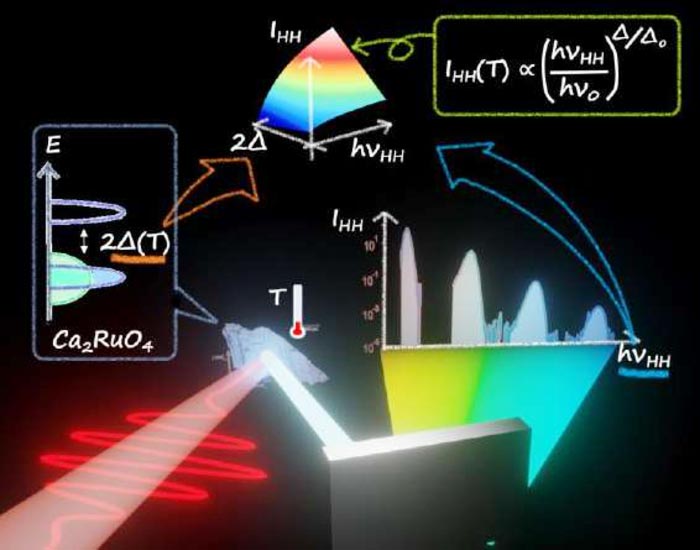Shedding new light on controlling material properties

Scaling law in Mott-insulating Ca2RuO4
Credit: KyotoU/Kento Uchida
New scaling law governing extreme nonlinear optical phenomena in solids discovered.
Materials scientists may soon be able to control material properties with light.
A team consisting of researchers at Kyoto University and Kurume Institute of Technology have discovered a scaling law that determines high-order harmonic generation in the solid-layered perovskite material, Ca2RuO4.
High-order harmonic generation is a nonlinear optical phenomenon where extreme ultraviolet photons are emitted by a material as a result of interactions with high intensity light.
“The phenomenon, which was first observed in atomic gas systems, has since paved the way to attosecond science,” says study author Kento Uchida. “But it is slightly more unpredictable in some strongly correlated solids, like Ca2RuO4.”
Due to the strong interaction between electrons in these solids, the characteristics of high-order harmonic generation can only be established by understanding how these electrons move in the presence of light.
To tackle this question, which has never been confirmed experimentally, the team set out to observe the relationship between temperature and photon emission in Ca2RuO4. They used a mid-infrared pulse to measure and map out high harmonic generation intensity at temperatures from an extremely low 50 to a moderate 290 Kelvin.
At the low end, the team recorded high-order harmonic generation several hundred times more intense than at room temperature. Photon emissions continued to intensify with increasing gap energy — the energy required for electrons to conduct electricity — along with the drop in temperature.
The team found that such emissions occurred in the Mott-insulating phase of the material, where the strong repulsion between electrons and high gap energy transforms the metal from an electrical conductor to an insulator.
“We discovered that high-order harmonics in strongly correlated materials highly depend on the gap energy of the materials,” explains Uchida.
This scaling law can direct theoretical studies towards more refined descriptions of non-equilibrium electron dynamics in strongly correlated materials: a central issue in condensed matter physics.
Uchida concludes, “Our findings also provide a foundation for materials design to achieve more efficient nonlinear optical devices.”
The paper “High-order harmonic generation and its unconventional scaling law in the Mott-insulating Ca2RuO4” appeared 23 March 2022 in Physical Review Letters, with doi: 10.1103/PhysRevLett.128.127401
About Kyoto University
Kyoto University is one of Japan and Asia’s premier research institutions, founded in 1897 and responsible for producing numerous Nobel laureates and winners of other prestigious international prizes. A broad curriculum across the arts and sciences at both undergraduate and graduate levels is complemented by numerous research centers, as well as facilities and offices around Japan and the world.
For more information please see: http://www.kyoto-u.ac.jp/en
Journal: Physical Review Letters
DOI: 10.1103/PhysRevLett.128.127401
Method of Research: Experimental study
Subject of Research: Not applicable
Article Title: High-order harmonic generation and its unconventional scaling law in the Mott-insulating Ca2RuO4
Article Publication Date: 23-Mar-2022
COI Statement: The authors declare there is no conflict of interest.
Media Contact
Jake Tobiyama
Kyoto University
tobiyama.gakuji.6y@kyoto-u.ac.jp
All latest news from the category: Materials Sciences
Materials management deals with the research, development, manufacturing and processing of raw and industrial materials. Key aspects here are biological and medical issues, which play an increasingly important role in this field.
innovations-report offers in-depth articles related to the development and application of materials and the structure and properties of new materials.
Newest articles

Largest magnetic anisotropy of a molecule measured at BESSY II
At the Berlin synchrotron radiation source BESSY II, the largest magnetic anisotropy of a single molecule ever measured experimentally has been determined. The larger this anisotropy is, the better a…

Breaking boundaries: Researchers isolate quantum coherence in classical light systems
LSU quantum researchers uncover hidden quantum behaviors within classical light, which could make quantum technologies robust. Understanding the boundary between classical and quantum physics has long been a central question…

MRI-first strategy for prostate cancer detection proves to be safe
Active monitoring is a sufficiently safe option when prostate MRI findings are negative. There are several strategies for the early detection of prostate cancer. The first step is often a…



